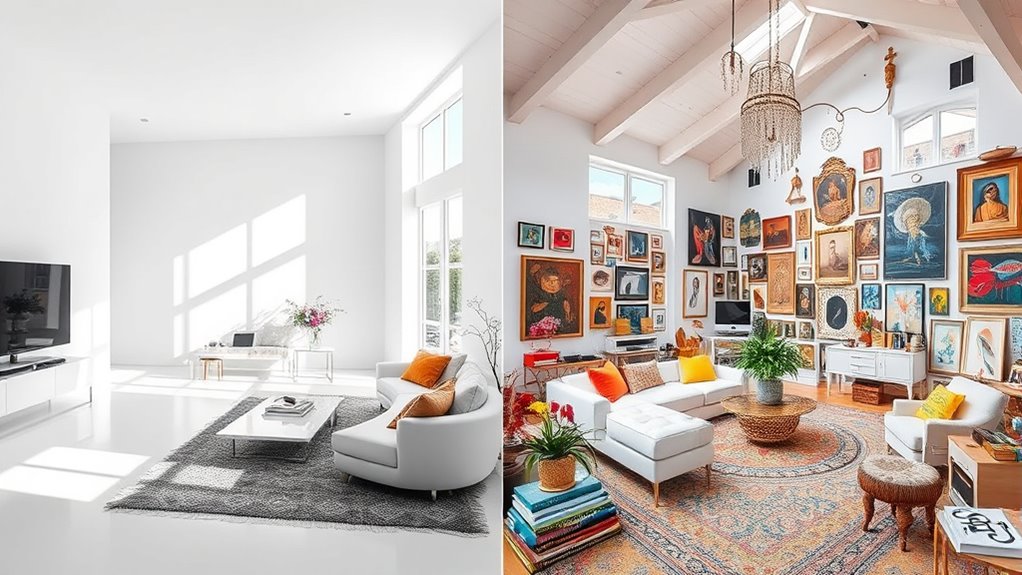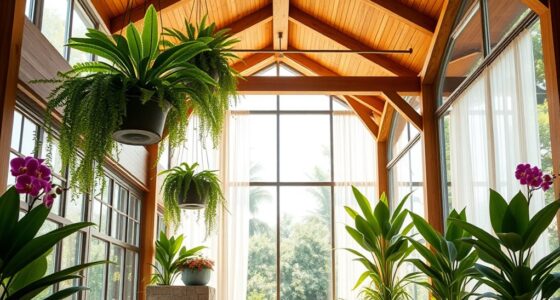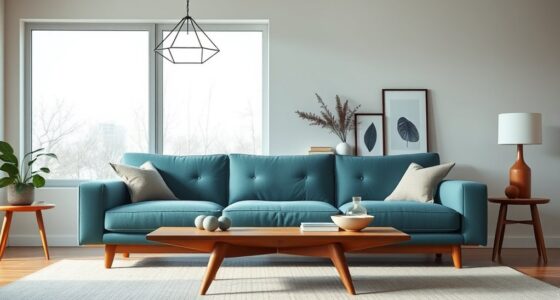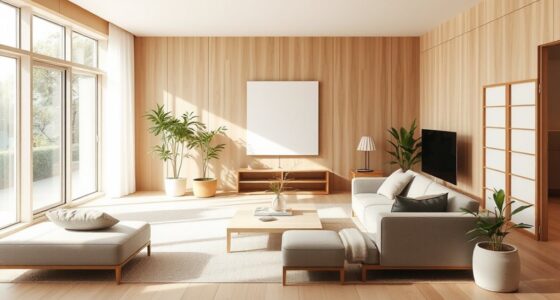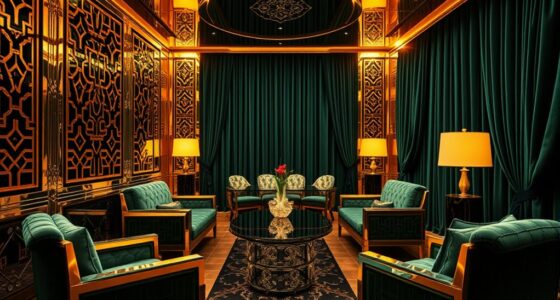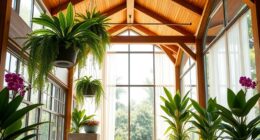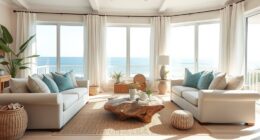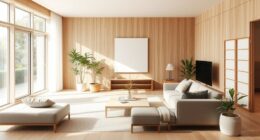In 2025 interiors, minimalism and maximalism continue to offer contrasting styles for personal expression. Minimalism favors neutral tones, sleek furniture, and open spaces that promote calm and focus. Maximalism bursts with vibrant colors, layered textures, and eclectic furnishings that energize and invite discovery. Your choice shapes the mood and personality of your space. Want to discover how to blend these trends seamlessly? Keep exploring to find more inspiring ideas and solutions.
Key Takeaways
- Minimalism in 2025 emphasizes open, clutter-free spaces with neutral palettes, promoting tranquility and focus.
- Maximalism trends highlight vibrant colors, layered textures, and eclectic decor to energize and personalize interiors.
- The blending of both styles reflects a personalized approach, balancing simplicity with bold self-expression.
- Trends reveal a shift toward multifunctional furniture and rich visual complexity for versatile living environments.
- Interior design in 2025 caters to individual needs, combining minimal calm with maximal personality for diverse lifestyles.
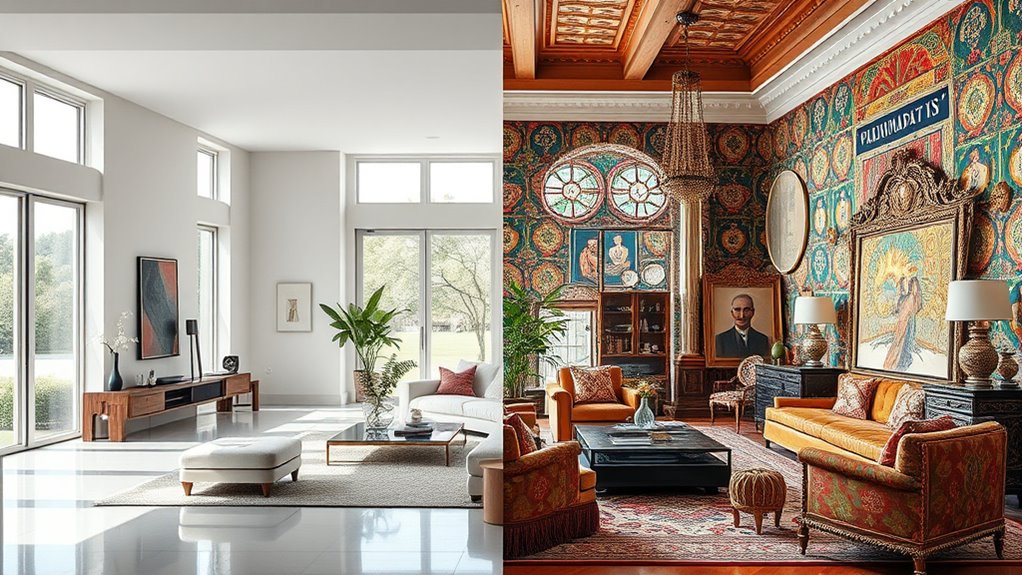
As interior design trends continue to evolve in 2025, the debate between minimalism and maximalism remains more vibrant than ever. You find yourself balancing two contrasting visions: one that champions simplicity and clean lines, and another that celebrates bold expressions and abundant details. When considering space utilization, minimalism encourages you to maximize openness and clarity. You opt for furniture that serves multiple functions, ensuring every piece has a purpose without cluttering your space. This approach allows your rooms to breathe, making them feel larger and more calming. Maximalism, on the other hand, invites you to fill every nook and cranny with personality. You layer furnishings, artwork, and accessories, creating a visually stimulating environment. Your goal is to craft a space bursting with character, where every item tells a story. Both styles influence how you think about space, but they do so in different ways—minimalism seeks to reduce excess, while maximalism embraces richness and complexity. When it comes to color palettes, minimalists tend to favor neutral tones like whites, beiges, and soft grays. These colors promote tranquility and help your space appear more expansive. You might add subtle accents in muted shades to create depth without overwhelming the senses. Maximalists prefer a vibrant mix of hues—deep jewel tones, bright primaries, and layered patterns—that reflect personality and energy. You might choose rich reds, emerald greens, or bold blues, combining them with intricate textures and prints. This approach makes your interiors lively and engaging, encouraging exploration and discovery. Incorporating diverse design elements such as quirky shapes, colors, and materials can further distinguish maximalist interiors, adding to their visual richness. The choice of color palettes directly impacts your mood and how you experience the space. Minimalist environments foster calm and focus, ideal for work or relaxation. Maximalist spaces stimulate creativity and conversation, perfect for social gatherings. As you navigate these trends, you realize that your personal preferences and lifestyle shape your decisions. If you value serenity and simplicity, minimalism offers a sanctuary that feels uncluttered and peaceful. If you thrive on variety and visual interest, maximalism provides a dynamic backdrop that energizes you. Ultimately, both styles serve different purposes, and your challenge lies in blending elements to create a space that resonates with you. Whether you lean toward sleek, understated designs or bold, layered aesthetics, understanding how space utilization and color palettes function within each trend helps you craft interiors that reflect your identity. This ongoing dialogue between minimalism and maximalism in 2025 allows you to explore new ways of expressing yourself through your environment, making your home a true reflection of your personality and taste.
Frequently Asked Questions
How Do Minimalism and Maximalism Influence Energy Efficiency?
You can influence energy efficiency through minimalism by choosing simple designs that reduce clutter, leading to less energy consumption for heating and cooling. Maximalism, on the other hand, often involves layered insulation techniques to keep warmth in, which can also cut down energy use. Both styles impact energy efficiency differently, but smart choices in insulation and design help you lower your overall energy consumption regardless of your aesthetic preference.
Are There Hybrid Interior Styles Combining Minimalism and Maximalism?
You can absolutely create a hybrid style that blends minimalism and maximalism, and it’s more popular than ever. This hybrid style integration allows you to use balanced design concepts, combining sleek, simple lines with bold, vibrant accents. By mixing understated furniture with statement art pieces, you craft a space that’s both calming and energizing. It’s like having the best of both worlds, giving your interior a unique, personalized flair that’s perfectly balanced.
Which Color Palettes Are Trending for Each Style in 2025?
In 2025, minimalism favors neutral tones like soft beiges, cool grays, and muted whites, emphasizing color harmony and simple material choices for a serene atmosphere. Maximalism, on the other hand, thrives on bold, vibrant palettes such as jewel tones, rich reds, and emerald greens, complemented by eclectic textures and layered materials. These contrasting color palettes reflect each style’s core focus: simplicity versus expressive richness.
How Do These Styles Impact Interior Maintenance and Cleaning?
Minimalism makes cleaning routines easier because it involves fewer surfaces and clutter, reducing maintenance challenges. You’ll find it quicker to dust, wipe, and organize. Maximalism, on the other hand, can be more demanding since it features intricate patterns, multiple textures, and many decorative items that require extra effort to keep clean. With maximalist styles, plan for more frequent dusting and careful cleaning to maintain their vibrant, layered look.
What Are the Cost Implications of Adopting Minimalism or Maximalism?
Adopting minimalism is like planting a simple, sturdy tree—cost-effective and low-maintenance. You’ll enjoy significant cost savings on material expenses, as fewer decor pieces and streamlined furniture reduce upfront and ongoing costs. Maximalism, however, is more like tending a lush garden—higher material expenses due to abundant decor, furniture, and intricate details. While it costs more initially, it offers a rich aesthetic, but your budget needs to be ready for the investment.
Conclusion
Whether you embrace minimalism’s sleek serenity or plunge into maximalism’s vibrant chaos, your interior style is your personal canvas. Think of it as choosing between a calm, clear lake and a lively, swirling river—each offers its own beauty. By blending elements from both trends, you can create a space that feels uniquely yours, a harmonious dance between simplicity and bold expression. After all, your home should be a reflection of your true self, flowing effortlessly like nature’s own masterpiece.
